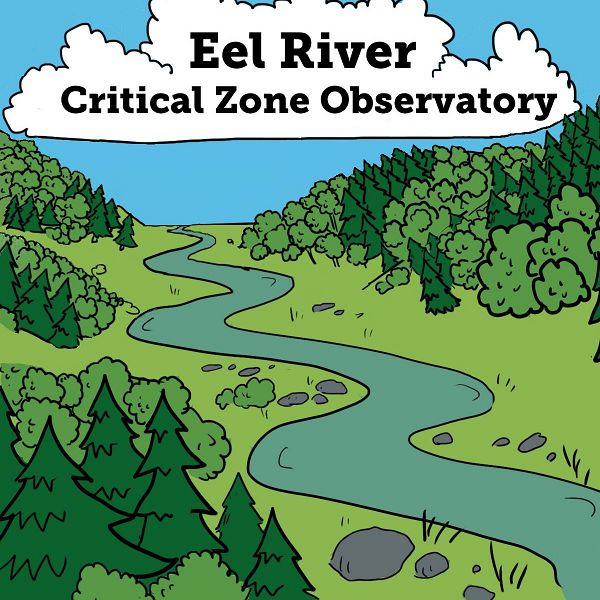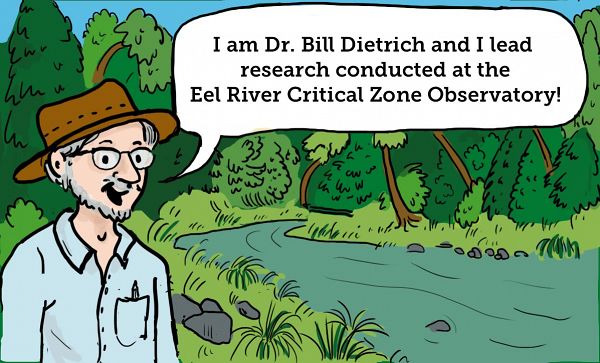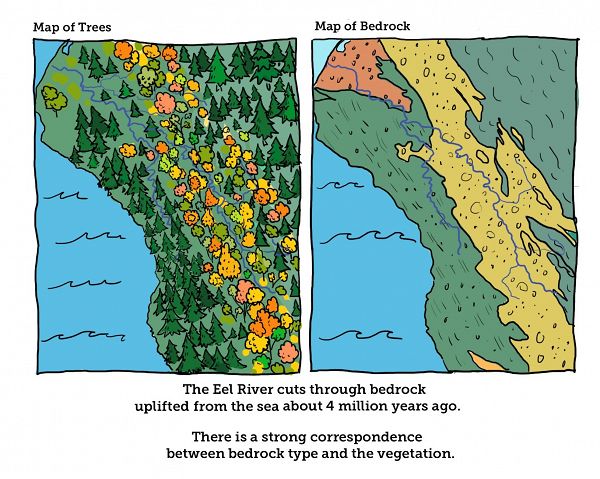What is the Eel River Critical Zone Observatory?
Justin Richardson in Adventures in the Critical Zone

Nov 02, 2017
An illustrated introduction to the Eel River Critical Zone Observatory!
By Dr. Bill E. Dietrich and Justin Richardson
Illustrated by Alana McGillis.
Panel 1. A river flows through a vegetated hilly landscape similar to that found in the Eel River Critical Zone Observatory (ERCZO).
Panel 2. Dr. Bill Dietrich stands by a river and says, “I am Dr. Bill Dietrich and I lead the research conducted at the ERCZO!”
Panel 3. The Eel River Watershed is a canyon river in the Northern California coastal mountains with forests, meadows, grasslands and river ecosystems. Home to many native plants and animals, river otters and streamside orchids are seen along a river while Steelhead trout swim along.
Panel 4. The Eel River cuts through bedrock uplifted from the sea about 4 million years ago. A map of trees and of bedrock show the strong correspondence between bedrock type and vegetation.
Panel 5. ERCZO researchers look deep inside hillslopes to understand where water moves beneath the surface and how bedrock and soil changes the water’s chemistry. As it rains on a hillslope, water moves through the soil, unsaturated and saturated weathered bedrock, and down to unweathered bedrock.
Panel 6. The ERCZO also explores how the CZ controls this movement of water, as well as; sediment, nutrients, gas, organism and energy in the CZ which influences the atmosphere and rivers.
Panel 7. Tree roots extend down into the saturated zone of a soil profile. It has been discovered that the weathered bedrock under hillslopes acts like a sponge to hold “rock moisture.” Trees use this moisture to survive long dry periods and is replenished during rainy periods. This “sponge” can hold one-third of all the annual rainfall at the ERCZO.
Panel 8. Drainage from this sponge also sustains river flow long after it’s stopped raining. All summer river flow comes from drainage of water stored in the CZ underlying hillslopes. Dry summers with low river flow can stress or kill salmon and other native river creatures and promote blooms of toxic cyanobacteria. Dr. Mary Power holds a piece of green, slimy algae that can bloom in the river during dry summers.
Panel 9. Over 800 measurements are recorded every few minutes in the ERCZO. Some instruments are installed after drilling over 100 feet into the ground shown by a drilling team and rig.
Panel 10. Dr. Dietrich, standing among ERCZO researchers, explains that looking inside hillslopes and following water into trees and out to rivers will enable us to connect the CZ to the atmosphere, to river ecosystems and even to the ocean.
Files
What is the Eel River Critical Zone Observatory?
(2 MB pdf)
Printable 2-page version of this comic.

Justin B. Richardson
CZO INVESTIGATOR, STAFF. National Office outreach officer, Former CZO Post-Doctoral Fellow. Specialty: Soil biogeochemistry of plant-essential and toxic metals.
Outreach / Education Research EDUCATION/OUTREACH General Public
COMMENT ON "Adventures in the Critical Zone"
All comments are moderated. If you want to comment without logging in, select either the "Start/Join the discussion" box or a "Reply" link, then "Name", and finally, "I'd rather post as a guest" checkbox.
ABOUT THIS BLOG
Justin Richardson and his guests answer questions about the Critical Zone, synthesize CZ research, and meet folks working at the CZ observatories
General Disclaimer: Any opinions, findings, conclusions or recommendations presented in the above blog post are only those of the blog author and do not necessarily reflect the views of the U.S. CZO National Program or the National Science Foundation. For official information about NSF, visit www.nsf.gov.
Explore Further











